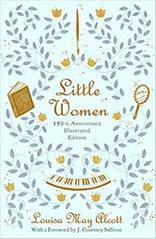 Last month marked the 150th anniversary of the publication of Louisa May Alcott's Little Women. Alcott introduced the four March sisters of Concord, Mass., in two volumes: part one, published in 1868, and part two, published in 1869 (copies sold in the United States usually put both parts in one book; in the U.K., part two is available separately as Good Wives). Widespread critical and commercial success led to two more sequels: Little Men (1871) and Jo's Boys (1886). Alcott (1832–1888) died at age 55 of a stroke. Much of her life was marked by her family's financial hardships prior to the publication of Little Women. The use of her own autobiographical details--each March sister matches one of the Alcotts--resonated with many women in all stations of society. Her work was a landmark in children's fiction, both ahead of its time and a guide for all that came after.
Last month marked the 150th anniversary of the publication of Louisa May Alcott's Little Women. Alcott introduced the four March sisters of Concord, Mass., in two volumes: part one, published in 1868, and part two, published in 1869 (copies sold in the United States usually put both parts in one book; in the U.K., part two is available separately as Good Wives). Widespread critical and commercial success led to two more sequels: Little Men (1871) and Jo's Boys (1886). Alcott (1832–1888) died at age 55 of a stroke. Much of her life was marked by her family's financial hardships prior to the publication of Little Women. The use of her own autobiographical details--each March sister matches one of the Alcotts--resonated with many women in all stations of society. Her work was a landmark in children's fiction, both ahead of its time and a guide for all that came after.
Much of the drama in Little Women stems from tension over expected social roles for girls entering adolescence and adulthood. Marriage and domestic work clash with wishes for freer living. Fifteen-year-old Josephine, Louisa's stand-in, harbors literary ambitions and, at least initially, has sworn off romance and marriage. Her story has since been adapted into two silent films, four talkies, six television series, an opera and a musical. On September 25, Little, Brown released a 150th-anniversary edition of Little Women with a new introduction by J. Courtney Sullivan ($24.99, 9780316489270). --Tobias Mutter

